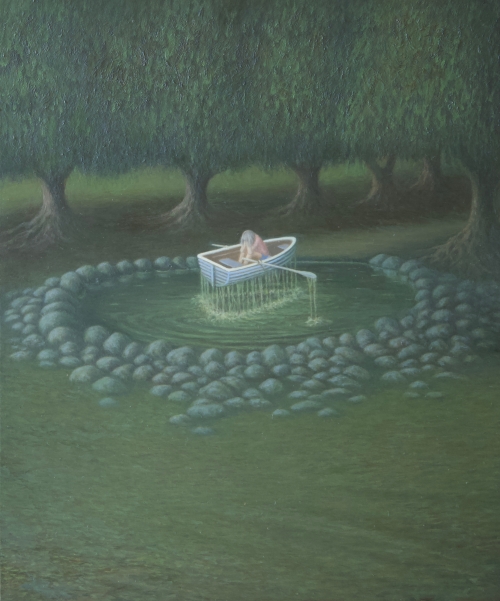
How does one deal with the excruciating pain of losing a 30-year-old son to mental illness?
Completely broken, Megan Murphy desperately tried to put the fractured pieces of her life together through art. A well-known artist by profession who has been running the Meganz School of Visual Arts since the last nine years, Megan tried to heal her mind, body and spirit through a sharpened pencil and paintbrush to create some deeply meaningful works of art. Megan and her daughter Greta Umbers, also a talented visual artist, talk to FARIDA MASTER about their current exhibition around loss and love. Showing at the Railway St Gallery, Newmarket, till August 9, the works of art tells a poignant story of dealing with grief.
A minute makes a world of difference between life and death.
On September 14, 2019, Callan, Megan’s son and Greta’s brother was there in flesh and blood, alive. 60 seconds later, life was extinguished. The spark gone!
Trying to process her world that was torn apart in the flicker of a minute, Megan grappled with shock and despair as she tried to pick up her paint brush again.
“It took me a year and a half to step back into the studio,” she says of her inner battle of processing the immense loss.
The tidal wave of emotional pain was palpable, unbearable. “I had a bursting sensation with chest pains. Each time I began to paint, the emotions would rise and tears would follow and I felt I couldn’t carry on. It was too overwhelming, agonising and empty.
“I kept thinking as I stared at the canvas, why bother, what’s the point? The absolute worst thing in the world has happened, my son has died, he is no more. These thoughts were overtaking any possible meaning or worth, so the work needed to come from a disconnected yet intuitive place.
“I had to step aside and just let them happen. The paintings that finally emerged were small and controlled, not letting me scream, perhaps even looking after me, as I hunched over them, curled up with a tiny brush. And yes, I still cried, but at least they let me paint them.”
That was the beginning of an exhaustive, uphill journey that enabled her to examine her emotions and ground herself.
Talking about how art can help heal and make sense of the world, Megan says that art allows one to step into a different zone as you connect with your inner world. “It’s much like writing poetry to express yourself. It’s been incredibly helpful for us,” she says.
Trusting the process that allows one to reflect, be mindful and flow with the rhythm has allowed both Megan and Greta find a connection within, occasional objectivity and equanimity along the way.

It took me a year and a half to step back into the studio,” Megan says of her inner battle of processing the immense loss.
“With these works that explore grief, consciousness, epigenetics and intergenerational transmission, we would hope to open up a conversation around mental health,” she says of the month of August being devoted to Mindfulness.
Megan admits that her previous series Sand Marks explored the connective thread of past and future. It was an unrecognised premonition of that final minute… “It was almost intuitive as there was an explosion in my series of work, a week before he died,” she ponders aloud. It has made her reflect on the concept consciousness and wonder where consciousness is seated.
Megan expresses her gratitude for Verona Ramadu from Sowers Trust who runs the Waves course, a grief education program for bereaved people who have lost their loved ones to suicide.
While the healing journey is ongoing, Megan says there have been moments when she has felt Callan’s presence. “We had Callan’s ashes in an earthen urn for a year after he died. The family went to Mt Maunganui to release his ashes. It was whilst I was there that I heard footsteps behind me. I turned around thinking it was Greta or my husband Lee. But then I saw no one. I almost felt his presence…as if Callan was standing there beside me.”
Greta says she deals with Callan’s death differently. While she doesn’t believe in spiritual dimensions, she agrees that releasing Callan’s ashes in the water “felt as if it was a release for him.”
For Greta, the journey of grief, loss and healing has allowed her to dig deep and come up with some powerful works of art. In her practice, Umbers considers how the past informs the present and how the body holds emotional memory.
One of the drawings she made as part of this body of work has been selected as a finalist in this year’s Parkin Drawing Prize. The prestigious Parkin Drawing Prize with a major prize of $20,000 was established by Chris Parkin, arts patron and owner of Museum Art Hotel in Wellington.
The work had to be sent down to Wellington for the prize.
16:34/16.35 – Megan Murphy and Greta Umbers

At 16:34 on September 14, 2019, Callan was alive. At 16:35, his life and the complex patterns of generations past—reaching back, all the way to the stars—collapsed into that single minute as his heartbeat faded away to stillness.
There was before 16:34, and now there is after 16:35. The same world but fundamentally different.
16:34 | 16:35 (the moment of transition between life and death), considers the psychological space formed by loss, and attempts to contend with the dislocating presence of eternal absence, and to reconcile the precariousness of life with the necessity for restoration and continuation.
As grief is both a collective and an individual experience, Murphy and Umbers chose to produce independent bodies of work they would later integrate as one.
In her practice, Umbers considers how the past informs the present, and how the body holds emotional memory.
In 16:34 | 16:35, she examines how grief, loss, and mental instability cause an emotional and cognitive dissonance that alters the rhythm of life, confusing biographical temporality. Her use of graphite generates a play of light that reflects simultaneous timescales, locating one in the past, present, and future.


